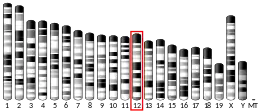40S ribosomal protein S29
40S ribosomal protein S29 is a protein that in humans is encoded by the RPS29 gene.[5][6][7]
| RPS29 | |||||||||||||||||||||||||||||||||||||||||||||||||||
|---|---|---|---|---|---|---|---|---|---|---|---|---|---|---|---|---|---|---|---|---|---|---|---|---|---|---|---|---|---|---|---|---|---|---|---|---|---|---|---|---|---|---|---|---|---|---|---|---|---|---|---|
| |||||||||||||||||||||||||||||||||||||||||||||||||||
| Identifiers | |||||||||||||||||||||||||||||||||||||||||||||||||||
| Aliases | RPS29, DBA13, S29, ribosomal protein S29, uS14 | ||||||||||||||||||||||||||||||||||||||||||||||||||
| External IDs | OMIM: 603633 MGI: 107681 HomoloGene: 83197 GeneCards: RPS29 | ||||||||||||||||||||||||||||||||||||||||||||||||||
| |||||||||||||||||||||||||||||||||||||||||||||||||||
| |||||||||||||||||||||||||||||||||||||||||||||||||||
| |||||||||||||||||||||||||||||||||||||||||||||||||||
| |||||||||||||||||||||||||||||||||||||||||||||||||||
| |||||||||||||||||||||||||||||||||||||||||||||||||||
| Wikidata | |||||||||||||||||||||||||||||||||||||||||||||||||||
| |||||||||||||||||||||||||||||||||||||||||||||||||||
Function
Ribosomes, the organelles that catalyze protein synthesis, consist of a small 40S subunit and a large 60S subunit. Together these subunits are composed of 4 RNA species and approximately 80 structurally distinct proteins. This gene encodes a ribosomal protein that is a component of the 40S subunit and a member of the S14P family of ribosomal proteins. The protein, which contains a C2-C2 zinc finger-like domain that can bind to zinc, can enhance the tumor suppressor activity of Ras-related protein 1A (KREV1). It is located in the cytoplasm. Variable expression of this gene in colorectal cancers compared to adjacent normal tissues has been observed, although no correlation between the level of expression and the severity of the disease has been found. As is typical for genes encoding ribosomal proteins, there are multiple processed pseudogenes of this gene dispersed through the genome.[7]
Clinical significance
Mutations in RPS29 cause Diamond–Blackfan anemia.[8]
References
- GRCh38: Ensembl release 89: ENSG00000213741 - Ensembl, May 2017
- GRCm38: Ensembl release 89: ENSMUSG00000034892 - Ensembl, May 2017
- "Human PubMed Reference:". National Center for Biotechnology Information, U.S. National Library of Medicine.
- "Mouse PubMed Reference:". National Center for Biotechnology Information, U.S. National Library of Medicine.
- Kondoh N, Noda M, Fisher RJ, Schweinfest CW, Papas TS, Kondoh A, Samuel KP, Oikawa T (August 1996). "The S29 ribosomal protein increases tumor suppressor activity of K rev-1 gene on v-K ras-transformed NIH3T3 cells". Biochimica et Biophysica Acta (BBA) - Molecular Cell Research. 1313 (1): 41–6. doi:10.1016/0167-4889(96)00052-3. PMID 8781548.
- Frigerio JM, Dagorn JC, Iovanna JL (May 1995). "Cloning, sequencing and expression of the L5, L21, L27a, L28, S5, S9, S10 and S29 human ribosomal protein mRNAs". Biochimica et Biophysica Acta (BBA) - Gene Structure and Expression. 1262 (1): 64–8. doi:10.1016/0167-4781(95)00045-i. PMID 7772601.
- "Entrez Gene: RPS29 ribosomal protein S29".
- Mirabello L, Macari ER, Jessop L, Ellis SR, Myers T, Giri N, Taylor AM, McGrath KE, Humphries JM, Ballew BJ, Yeager M, Boland JF, He J, Hicks BD, Burdett L, Alter BP, Zon L, Savage SA (July 2014). "Whole-exome sequencing and functional studies identify RPS29 as a novel gene mutated in multicase Diamond-Blackfan anemia families". Blood. 124 (1): 24–32. doi:10.1182/blood-2013-11-540278. PMC 4125351. PMID 24829207.
Further reading
- Wool IG, Chan YL, Glück A (1996). "Structure and evolution of mammalian ribosomal proteins". Biochemistry and Cell Biology. 73 (11–12): 933–47. doi:10.1139/o95-101. PMID 8722009.
- Vladimirov SN, Ivanov AV, Karpova GG, Musolyamov AK, Egorov TA, Thiede B, Wittmann-Liebold B, Otto A (July 1996). "Characterization of the human small-ribosomal-subunit proteins by N-terminal and internal sequencing, and mass spectrometry". European Journal of Biochemistry. 239 (1): 144–9. doi:10.1111/j.1432-1033.1996.0144u.x. PMID 8706699.
- Kenmochi N, Kawaguchi T, Rozen S, Davis E, Goodman N, Hudson TJ, Tanaka T, Page DC (May 1998). "A map of 75 human ribosomal protein genes". Genome Research. 8 (5): 509–23. doi:10.1101/gr.8.5.509. PMID 9582194.
- Coppock D, Kopman C, Gudas J, Cina-Poppe DA (March 2000). "Regulation of the quiescence-induced genes: quiescin Q6, decorin, and ribosomal protein S29". Biochemical and Biophysical Research Communications. 269 (2): 604–10. doi:10.1006/bbrc.2000.2324. PMID 10708601.
- Bortoluzzi S, d'Alessi F, Romualdi C, Danieli GA (December 2001). "Differential expression of genes coding for ribosomal proteins in different human tissues". Bioinformatics. 17 (12): 1152–7. doi:10.1093/bioinformatics/17.12.1152. PMID 11751223.
- Yoshihama M, Uechi T, Asakawa S, Kawasaki K, Kato S, Higa S, Maeda N, Minoshima S, Tanaka T, Shimizu N, Kenmochi N (March 2002). "The human ribosomal protein genes: sequencing and comparative analysis of 73 genes". Genome Research. 12 (3): 379–90. doi:10.1101/gr.214202. PMC 155282. PMID 11875025.
- Zhou ZD, Bao L, Liu DG, Li MQ, Ge YZ, Huang YL, Liu WY (February 2003). "Low content of protein S29 in ribosomes of human lung cancer cell line a549: detected by two-dimensional electrophoresis". Protein and Peptide Letters. 10 (1): 91–7. doi:10.2174/0929866033408273. PMID 12625830.
- Yu Y, Ji H, Doudna JA, Leary JA (June 2005). "Mass spectrometric analysis of the human 40S ribosomal subunit: native and HCV IRES-bound complexes". Protein Science. 14 (6): 1438–46. doi:10.1110/ps.041293005. PMC 2253395. PMID 15883184.
- Ewing RM, Chu P, Elisma F, Li H, Taylor P, Climie S, McBroom-Cerajewski L, Robinson MD, O'Connor L, Li M, Taylor R, Dharsee M, Ho Y, Heilbut A, Moore L, Zhang S, Ornatsky O, Bukhman YV, Ethier M, Sheng Y, Vasilescu J, Abu-Farha M, Lambert JP, Duewel HS, Stewart II, Kuehl B, Hogue K, Colwill K, Gladwish K, Muskat B, Kinach R, Adams SL, Moran MF, Morin GB, Topaloglou T, Figeys D (2007). "Large-scale mapping of human protein-protein interactions by mass spectrometry". Molecular Systems Biology. 3 (1): 89. doi:10.1038/msb4100134. PMC 1847948. PMID 17353931.



